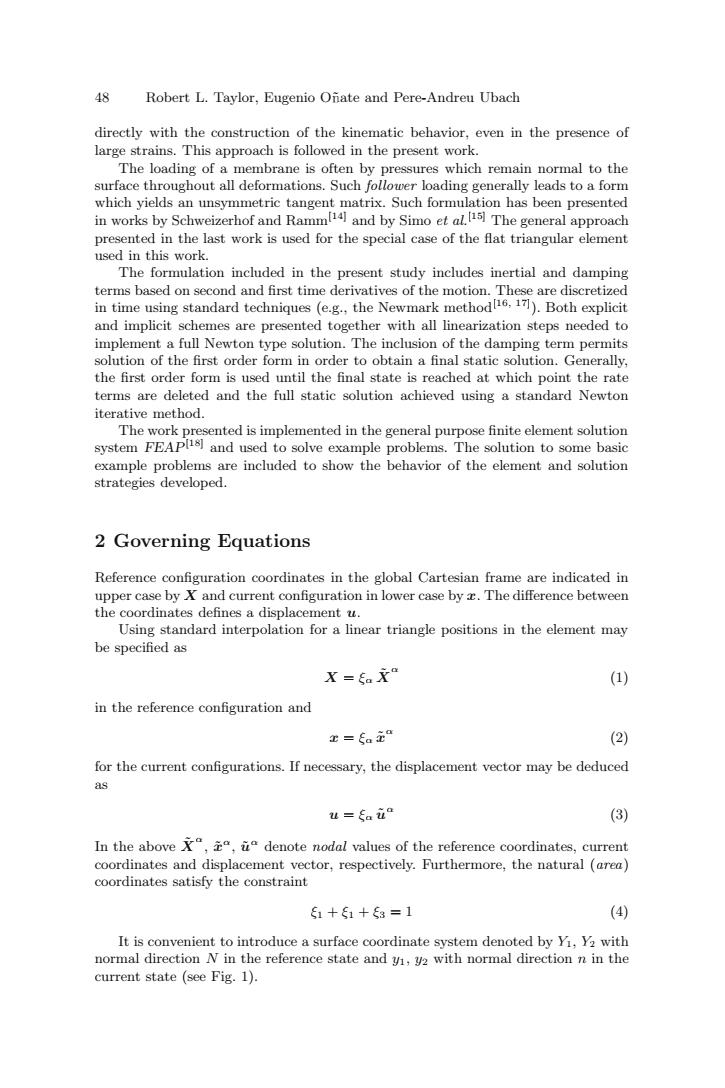正在加载图片...

48 Robert L.Taylor,Eugenio Onate and Pere-Andreu Ubach directly with the construction of the kinematic behavior,even in the presence of large strains.This approach is followed in the present work. The loading of a membrane is often by pressures which remain normal to the surface throughout all deformations.Such follower loading generally leads to a form which yields an unsymmetric tangent matrix.Such formulation has been presented in works by Schweizerhof and Ramm4l and by Simo et al The general approach presented in the last work is used for the special case of the flat triangular element used in this work. The formulation included in the present study includes inertial and damping terms based on second and first time derivatives of the motion.These are discretized in time using standard techniques (e.g.,the Newmark method6,171).Both explicit and implicit schemes are presented together with all linearization steps needed to implement a full Newton type solution.The inclusion of the damping term permits solution of the first order form in order to obtain a final static solution.Generally, the first order form is used until the final state is reached at which point the rate terms are deleted and the full static solution achieved using a standard Newton iterative method. The work presented is implemented in the general purpose finite element solution system FEAPlsl and used to solve example problems.The solution to some basic example problems are included to show the behavior of the element and solution strategies developed. 2 Governing Equations Reference configuration coordinates in the global Cartesian frame are indicated in upper case by X and current configuration in lower case by c.The difference between the coordinates defines a displacement u. Using standard interpolation for a linear triangle positions in the element may be specified as X=Eax (1) in the reference configuration and =ata (2) for the current configurations.If necessary,the displacement vector may be deduced as u =faua (3) In the above x,ua denote nodal values of the reference coordinates,current coordinates and displacement vector,respectively.Furthermore,the natural (area) coordinates satisfy the constraint 51+51+53=1 (4) It is convenient to introduce a surface coordinate system denoted by Yi,Y2 with normal direction N in the reference state and yi,y2 with normal direction n in the current state (see Fig.1).48 Robert L. Taylor, Eugenio O˜nate and Pere-Andreu Ubach ˜ directly with the construction of the kinematic behavior, even in the presence of large strains. This approach is followed in the present work. The loading of a membrane is often by pressures which remain normal to the surface throughout all deformations. Such follower loading generally leads to a form which yields an unsymmetric tangent matrix. Such formulation has been presented in works by Schweizerhof and Ramm[14] and by Simo et al. [15] The general approach presented in the last work is used for the special case of the flat triangular element used in this work. The formulation included in the present study includes inertial and damping terms based on second and first time derivatives of the motion. These are discretized in time using standard techniques (e.g., the Newmark method[16, 17] ). Both explicit and implicit schemes are presented together with all linearization steps needed to implement a full Newton type solution. The inclusion of the damping term permits solution of the first order form in order to obtain a final static solution. Generally, the first order form is used until the final state is reached at which point the rate terms are deleted and the full static solution achieved using a standard Newton iterative method. The work presented is implemented in the general purpose finite element solution system FEAP[18] and used to solve example problems. The solution to some basic example problems are included to show the behavior of the element and solution strategies developed. 2 Governing Equations Reference configuration coordinates in the global Cartesian frame are indicated in upper case by X and current configuration in lower case by x. The difference between the coordinates defines a displacement u. Using standard interpolation for a linear triangle positions in the element may be specified as X = ξα X˜ α (1) in the reference configuration and x = ξα x˜α (2) for the current configurations. If necessary, the displacement vector may be deduced as u = ξα u˜ α (3) In the above X˜ α , x˜α, u˜ α denote nodal values of the reference coordinates, current coordinates and displacement vector, respectively. Furthermore, the natural (area) coordinates satisfy the constraint ξ1 + ξ1 + ξ3 = 1 (4) It is convenient to introduce a surface coordinate system denoted by Y1, Y2 with normal direction N in the reference state and y1, y2 with normal direction n in the current state (see Fig. 1)